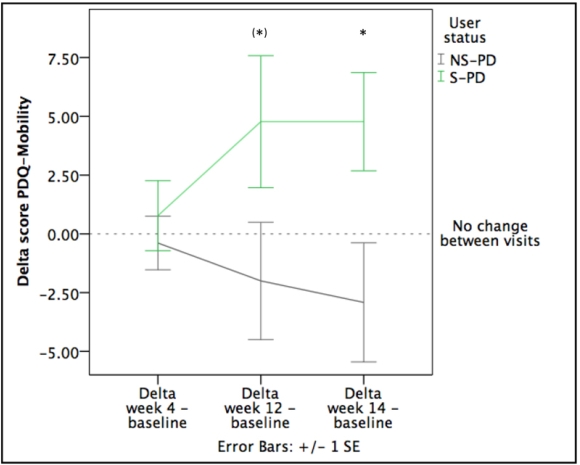Session Information
Date: Monday, June 20, 2016
Session Title: Quality of life/caregiver burden in movement disorders
Session Time: 12:30pm-2:00pm
Location: Exhibit Hall located in Hall B, Level 2
Objective: To evaluate the effects of using wearables over a long time period on Health-Related Quality of Life (HRQoL) in Parkinson’s disease (PD) patients.
Background: Wearable systems such as body-worn sensors used in the domestic environment have the potential to revolutionise the assessment of PD. At present, it is not well understood which factors influence the motivation of PD patients to use wearables. Therefore we ran a multicentre 12-week observational study with patients wearing a SENSE-PARK sensor system 24/7 in their home environment.
Methods: Twenty-two PD patients (8 female, 14 male: mean age 60.7 years) were assigned to either the SENSE-PARK sensor system group (S-PD) or the non-sensor group (NS-PD). The SENSE-PARK assesses daytime (three sensors) and night-time (one sensor) movements. In the last eight weeks of the study, the S-PD group received daily feedback on the following features: tremor, dyskinesia/ hypokinesia, and gait. HRQoL was assessed at baseline and after 4, 12, and 14 weeks, using the Parkinson’s disease Questionnaire-39 (PDQ-39). Delta HRQoL scores were calculated by subtracting follow-up scores from baseline scores. The primary outcome measure was the delta PDQ-Summary Index (SI); secondary outcome variables were deltas of the PDQ-mobility and PDQ-Activities of Daily Living (ADL) scores.
Results: The primary outcome was not significantly different between the two groups. The secondary outcomes indicated that the S-PD group improved in the PDQ-mobility domain: this approached significance at the end of the sensor-wearing phase and was significant at follow-up (Figure 1, Table 1, 2). 
| Delta week 4 to baseline S-PD | Delta week 4 to baseline NS-PD | Delta week 12 to baseline S-PD | Delta week 12 to baseline NS-PD | Delta week 14 to baseline S-PD | Delta week 14 to baseline NS-PD | |
| PDQ-SI | 1.76 | 2.19 | 3.77 | 3.50 | 2.56 | 4.17 |
| PDQ-MOB | 0.77 | -0.50 | 4.78 | -2.00 | 4.78 | -2.92 |
| PDQ-ADL | 5.29 | 0.98 | 9.47 | 2.55 | 4.18 | 1.81 |
| Week 4 to baseline S-PD VS NS-PD | Week 12 to baseline S-PD VS NS-PD | Week 14 to baseline S-PD VS NS-PD | |
| PDQ-SI | 0.88 | 0.94 | 0.71 |
| PDQ-MOB | 0.52 | 0.09 | 0.04 |
| PDQ-ADL | 0.33 | 0.23 | 0.69 |
Conclusions: Our main finding –no significant change in overall perceived HRQoL during a long observation period– indicates that it is possible to use wearables for the assessment of PD symptoms in the home environment. The significant improvement in the PDQ-mobility domain at the end of the study in the S-PD cohort indicates that the provision of feedback from sensor data to the users underlies this increase. Feedback appears to enhance motivation of the users to wear such technology. Our results justify a further investigation of the influence of the continuous and long-term use of wearables for the assessment of PD symptoms.
To cite this abstract in AMA style:
J.M.T. Van Uem, K.S. Maier, A.T. Santos, O. Fagerbakke, F. Larsen, J.J. Ferreira, W. Maetzler. Twelve-week sensor assessment in Parkinson’s disease: Impact on quality of life [abstract]. Mov Disord. 2016; 31 (suppl 2). https://www.mdsabstracts.org/abstract/twelve-week-sensor-assessment-in-parkinsons-disease-impact-on-quality-of-life/. Accessed December 31, 2025.« Back to 2016 International Congress
MDS Abstracts - https://www.mdsabstracts.org/abstract/twelve-week-sensor-assessment-in-parkinsons-disease-impact-on-quality-of-life/
